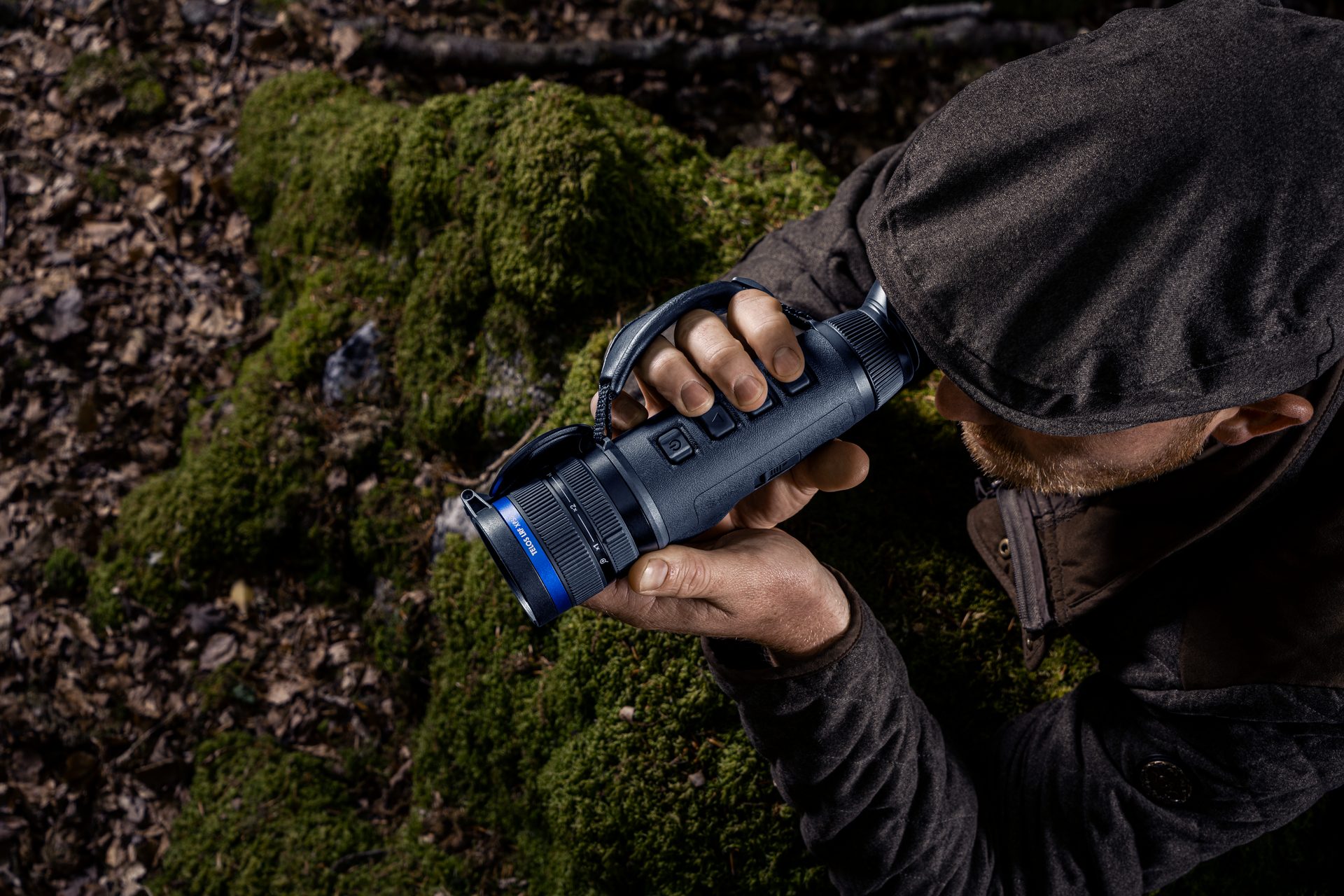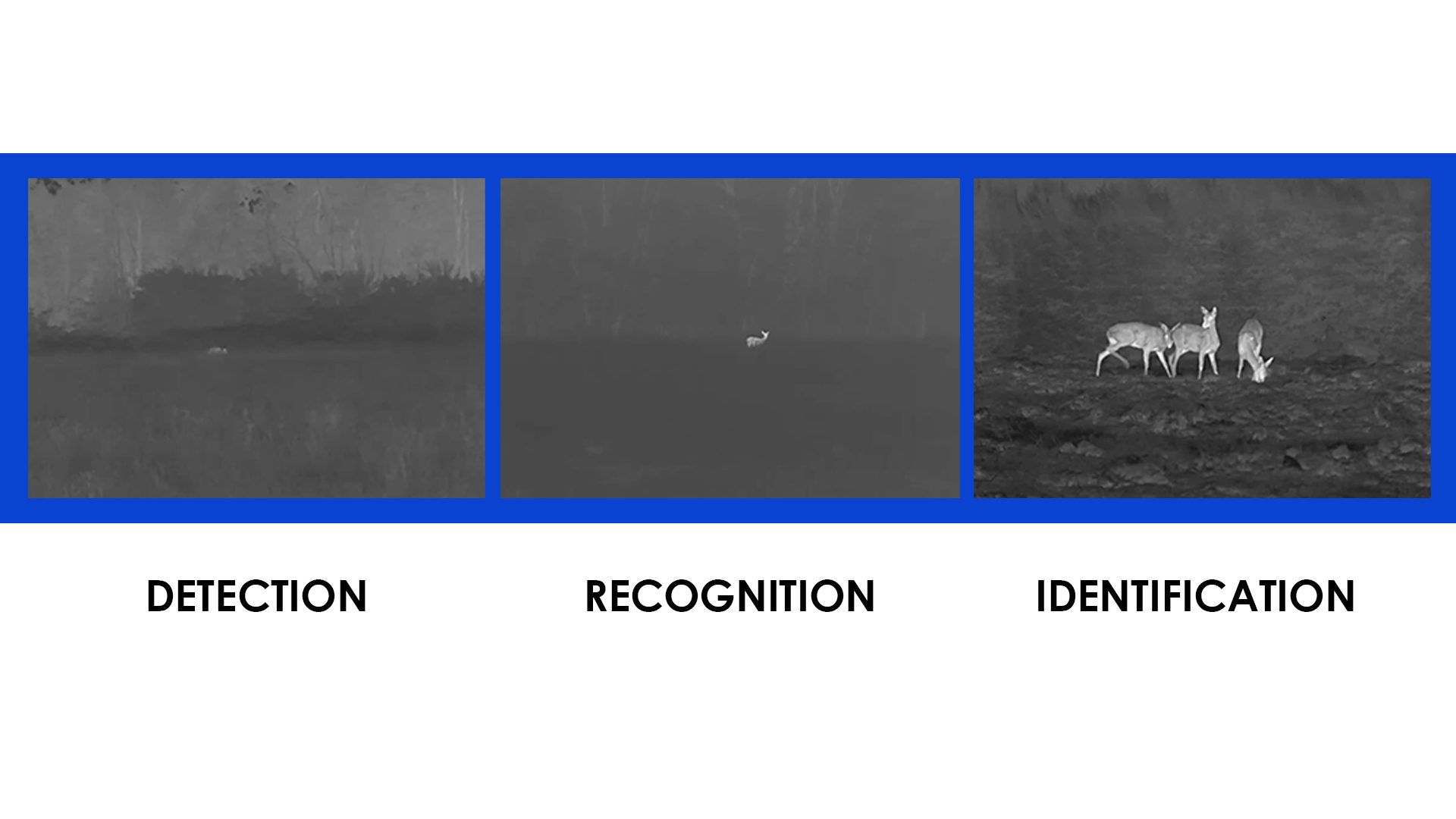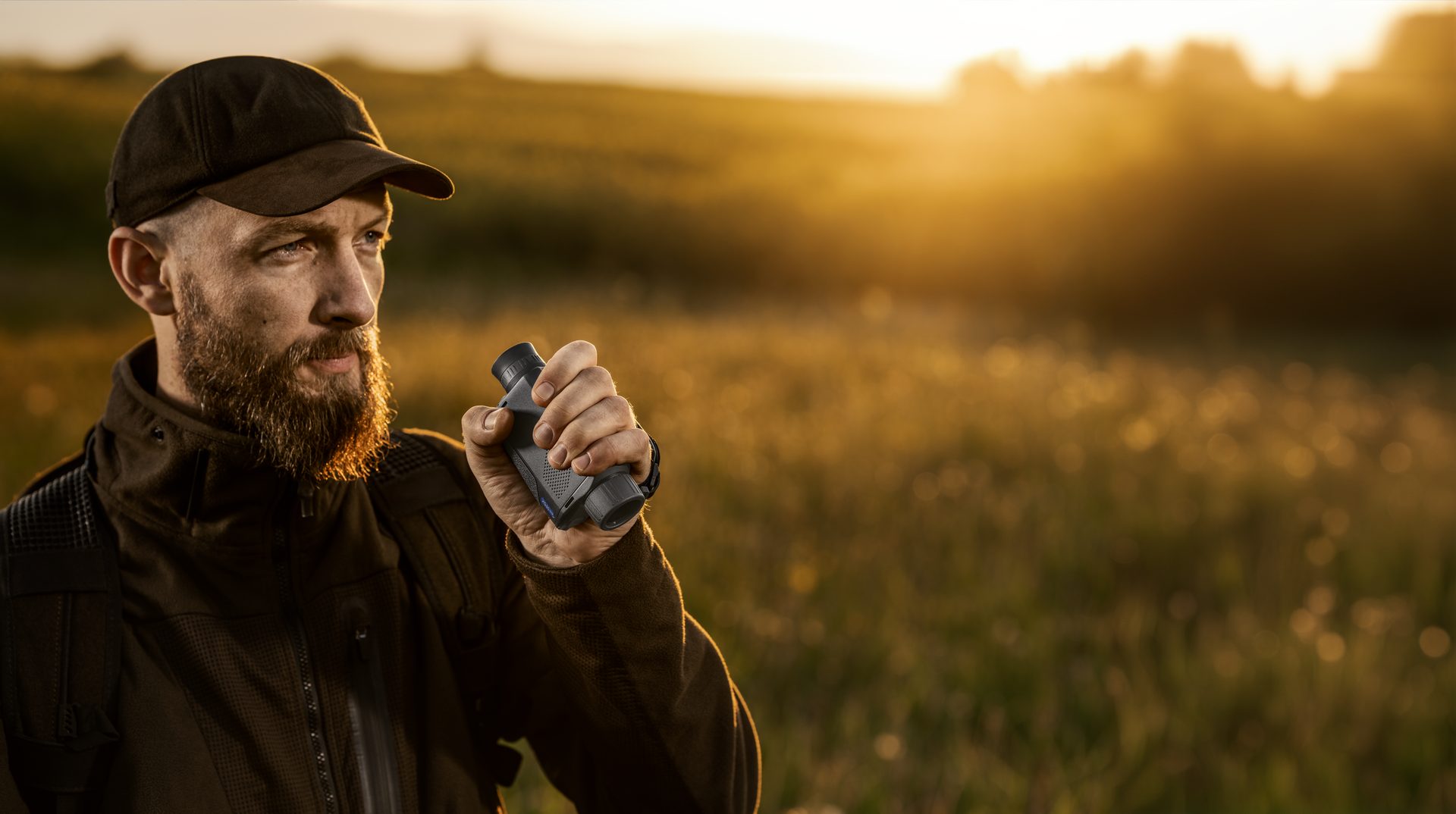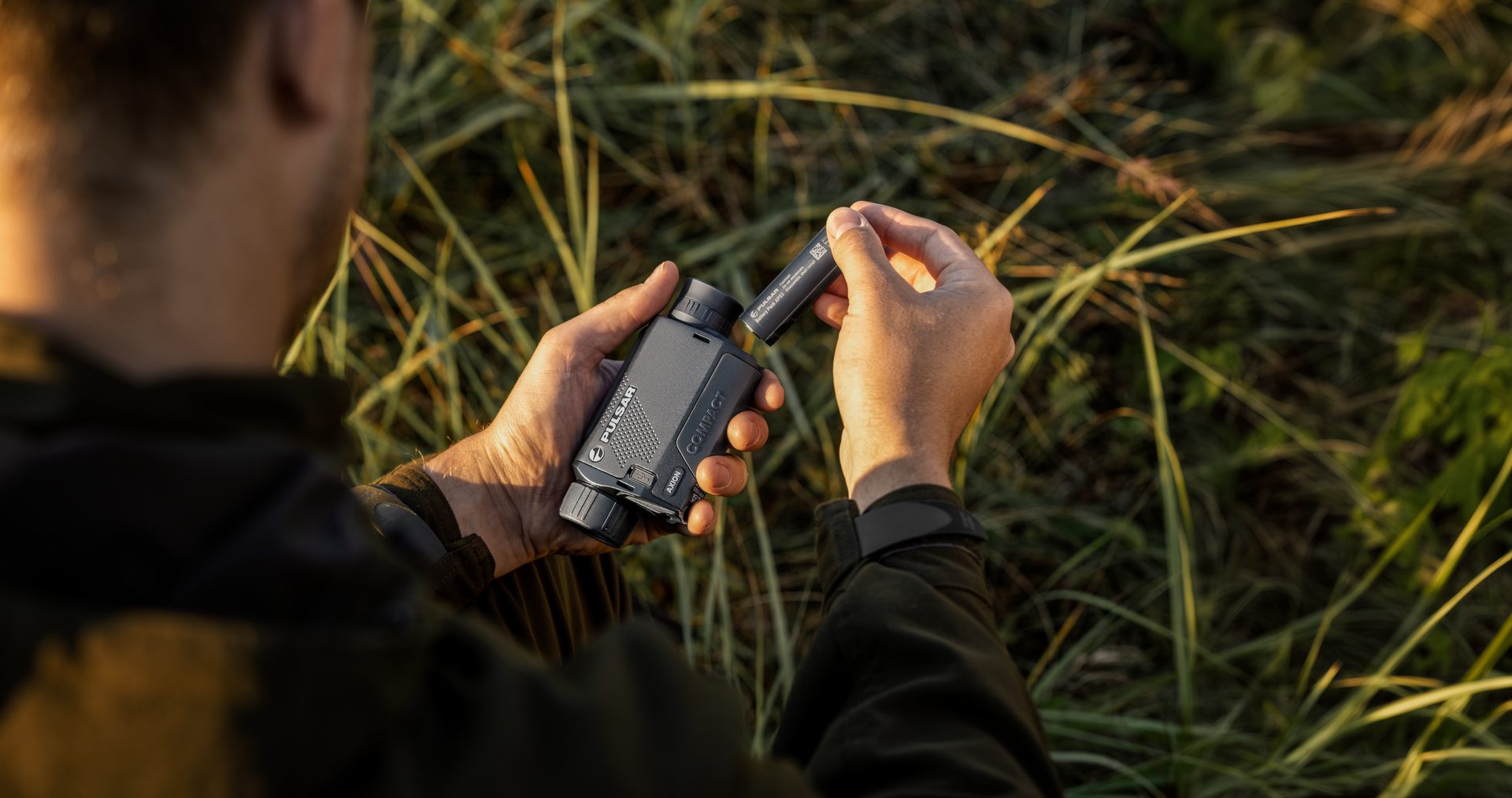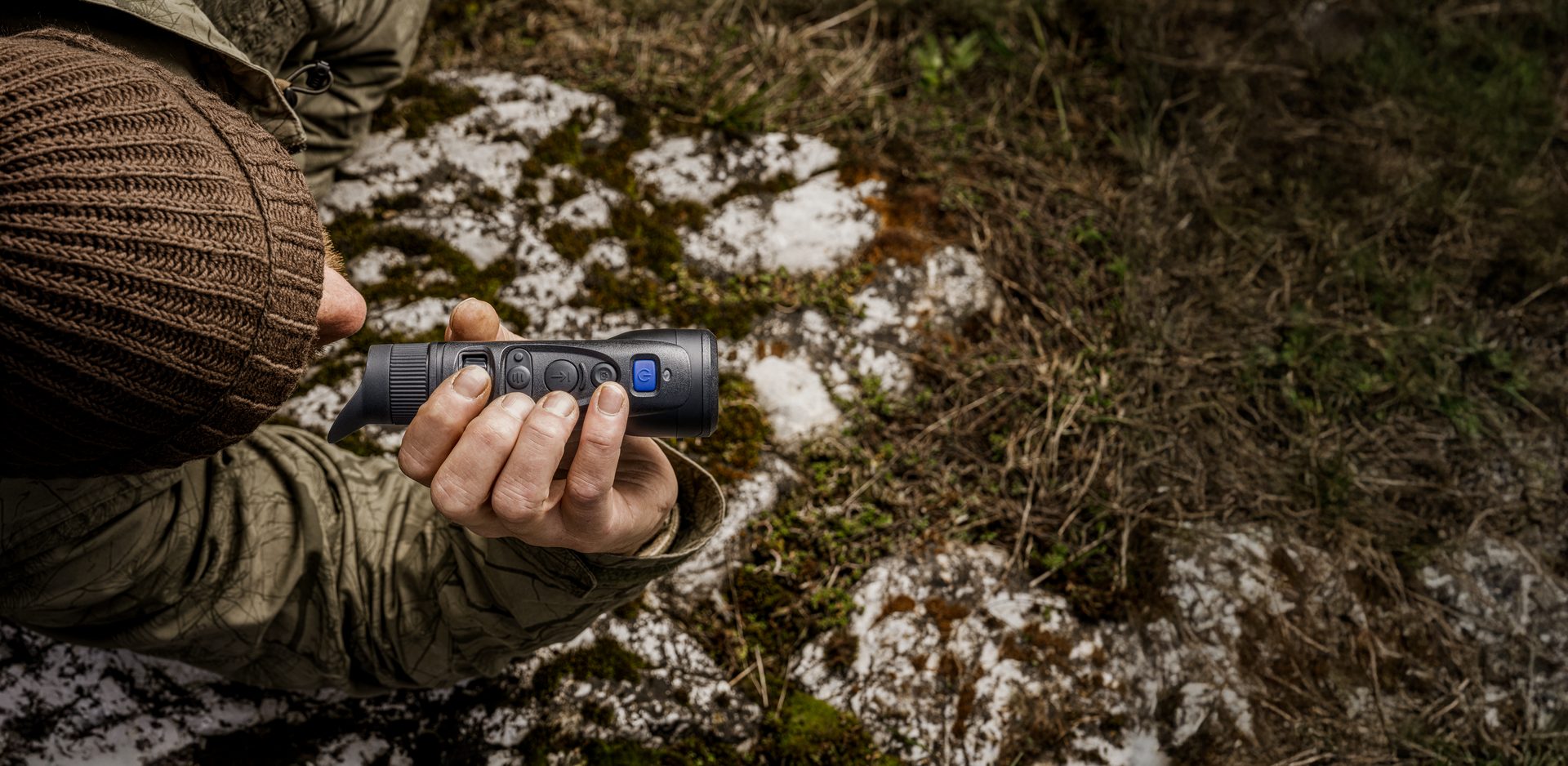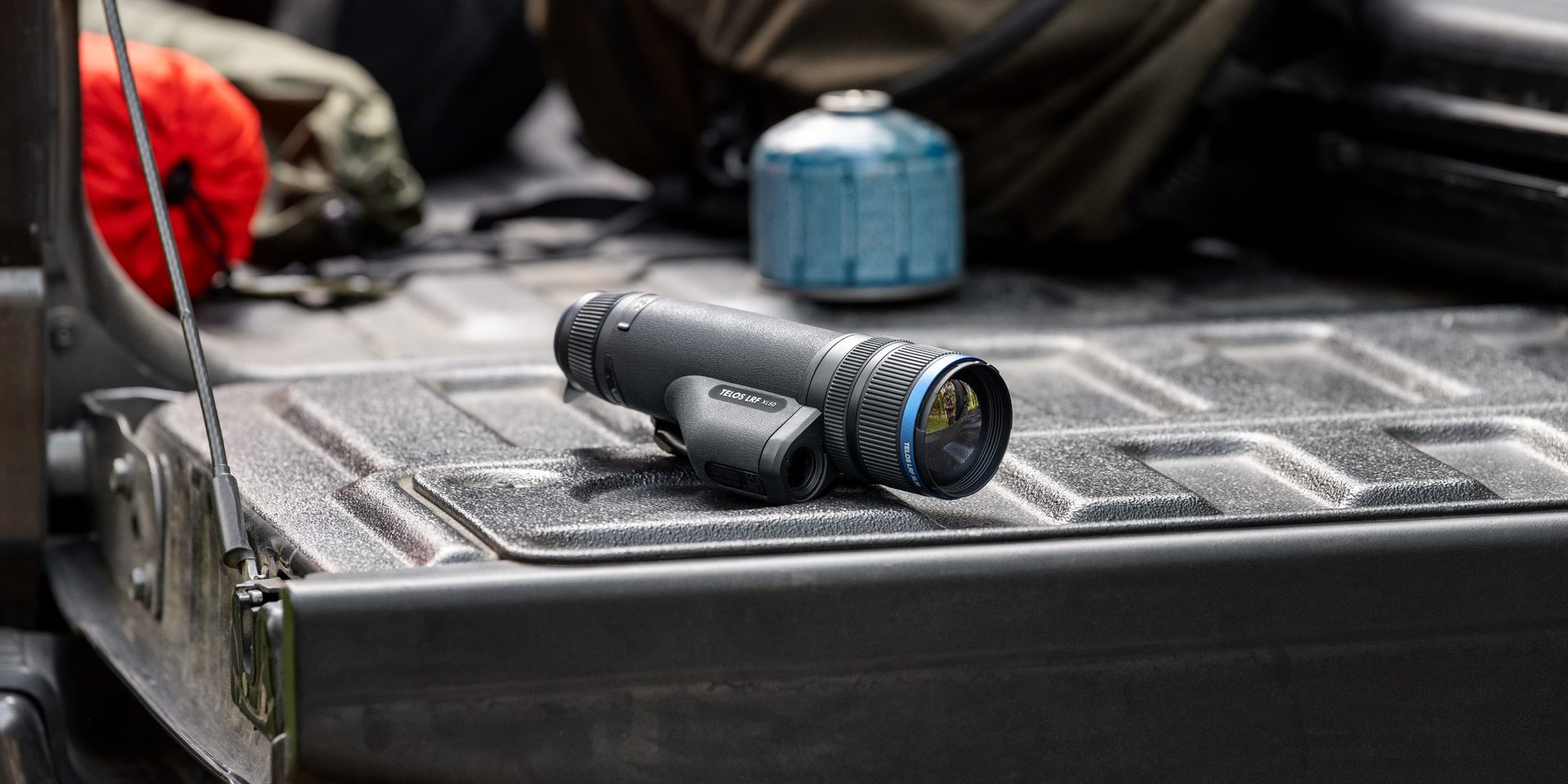Expert Contributor:
Riccardo Tamburini
Looking to upgrade your night hunting gear but unsure how to choose the right thermal monocular? You’re not alone. With so many specs – sensor resolution, sNETD, detection range – it’s easy to get overwhelmed. But the right choice can mean the difference between spotting game and missing it.
This expert buyer’s guide breaks down the essentials to help you make a confident, informed decision. Whether you hunt open fields, dense woodland, or rugged alpine terrain, you’ll learn how different features impact real-world performance – and which models are best suited to your style.
Expect practical advice, field-tested tips, and clear guidance rooted in Pulsar’s trusted expertise. From resolution clarity to mounting options, we’ll cover what matters – so you can hunt smarter, not harder.
The goal isn’t to pick the most expensive device — it’s to choose the right one for you.
Quick Answer
To choose the right thermal monocular for hunting, start by identifying where, how, and what you hunt. Match your choice to your terrain (woodland, open fields, mountains), target type, and weather conditions.
Then assess key specs like sensor resolution, thermal sensitivity (sNETD), detection range, field of view, and magnification – each directly affects clarity, range, and ease of target identification.
Instead of chasing spec sheets, align performance features with your real-world hunting needs. This guide breaks down every factor so you can choose based on use-case relevance, not marketing hype.
Key Factors to Consider Before Buying a Thermal Monocular
Understanding a thermal monocular’s core technical specifications is essential as they dictate image quality and detection capabilities. These include sensor resolution, thermal sensitvity (sNETD), objective lens size, and more. So, let’s dive in.
Sensor Resolution: How Much Detail Do You Really Need?
Sensor resolution, measured in pixels, determines image detail. The first number states how many pixels the sensor contains vertically, and the second – horizontally. Simply put, more pixels, aka higher resolution, means clearer images and bigger field of view (which we’ll discuss later). But more pixels also come at a higher price.
- 256×192: Entry-level, suitable for close-range detection and general awareness. The image will definitely be pixelated.
- 384×288: The “sweet spot.” Offers a significant leap in clarity for close and medium ranges, balancing performance and cost. Pulsar Axion XQ30 Pro Compact is the perfect example of this.
- 640×480 (or x512): Professional-grade. Provides exceptionally sharp, detailed images for precise identification at extended distances. Keep in mind that the only visible difference between 480 and 512 is vertical field of view, which in practice will be barely visible.
- 1024×768: Pinnacle of technology. Unparalleled detail and extreme long-range detection, but at a premium price. Thermal sensors with such resolution are called HD, and Pulsar was among the first to introduce an HD thermal monocular – the powerful Telos LRF XL50.
Sensor resolution, aka pixel count, is crucial. But pixel pitch – the distance between the centers of two adjacent pixels – is also important. Here’s how Riccardo Tamburini, a hunter with 10+ years of experience, describes the choice:
Generally speaking, you can choose between 12 µm or 17 µm. 12 µm helps you when you need good image quality at long distance. 17 µm is the best when you need an overall device or to get more details at low and mid distance (bigger size -> more details stored in a single pixel).
Riccardo’s tip:
Also consider that the first is smaller than the second, so if you need a compact size, go for the 12!
Expert summary:
The resolution of a thermal device is deeply connected with other important features, which make up the final price. Today, every hunter needs to acquire the maximum amount of info about the animal he or she’s observing. So, I always say: “According to your budget, get the best you can!”
Read more: Why pixel pitch matters
 Thermal Sensitivity (sNETD): Why mK Ratings Matter
Thermal Sensitivity (sNETD): Why mK Ratings Matter
NETD (Noise Equivalent Temperature Difference), expressed in millikelvin (mK), indicates the sensor’s ability to differentiate subtle temperature variations. A lower NETD means greater sensitivity, resulting in clearer, higher-contrast images, especially in challenging conditions like humidity or fog.
Now, this is where things get slightly complicated: not many brands are willing to share their NETD. Because it can be altered with image processing algorithms, most will share that changed number because it will be better.
So, NETD stands for sensor sensitivity, while system NETD (or sNETD) shows the sensitivity of the entire device after image processing.
At Pulsar, we share both: NETD for sensor and sNETD – the final one.
Read more: The nuances between NETD and sNETD
Now, let’s see what value you should look for:
- <40 mK: Good baseline for clear conditions, offering sufficient contrast.
- <25 mK: Significant improvement, providing noticeably better image quality in adverse weather or low-contrast situations.
- <18 mK and lower: Top-tier sensitivity. Delivers exceptionally high-contrast images even in heavy fog or mist.
Quick summary: sNETD determines image quality in adverse conditions; prioritize a lower value for optimal performance, especially if you often find yourself in humid conditions.
Decision Shortcut: For hunters operating in foggy, low-contrast terrain, the Pulsar Telos LRF XP50 with its <15 mK will be the perfect choice.
Objective Lens Size & Material: The Key to Range
The objective lens collects infrared radiation. Its size (diameter) and material fundamentally determine detection range and image quality.
- Objective Lens Size: Larger diameter (e.g., 50 mm vs. 35 mm) gathers more thermal energy, leading to greater detection range and a brighter image.
- Objective Lens Material: Germanium & Chalcogenide. Unlike conventional optics that use glass, thermal lenses must be made from materials transparent to infrared radiation. At Pulsar, we utilize both germanium and chalcogenide for our objective lenses. Both materials are excellent at efficiently transmitting infrared wavelengths, maximizing image quality and ensuring optimal performance.
- F-Number (F/): F/1.0 vs F/1.2: A lower f-number means a “faster” lens that collects more thermal radiation. F/1.0 is highly efficient, providing brighter, higher-contrast images, especially at extreme ranges. F/1.2 collects slightly less light.
Pulsar tip: A larger lens with a lower f-number (like F/1.0) provides superior performance, and our advice is to invest in the best you can.
Magnification & Zoom: Optical vs. Digital
Magnification brings distant targets closer – that’s kind of obvious. But it’s important to understand the difference between optical and digital zoom.
- Optical Magnification (Base Magnification): True, inherent magnification from the lens system, providing clear, unpixelated images. If you have a thermal imager with 2x base magnification, the objects will appear twice as close as they would with a naked eye. If the base mag is 4x, the objects will be 4 times closer.
- Digital Zoom: Electronically enlarges pixels, which may cause the image to become pixelated and blurry as you zoom in further.
- Zooming Without Pixelation: A high-resolution sensor allows for more digital zoom before significant pixelation occurs.
Prioritize a device with sufficient base magnification for your typical hunting distances and targets – the smaller they are and the further they appear, the higher the base magnification should be.
One more thing to note: higher base magnification will often mean smaller field of view. For example, the Pulsar Axion XG35 Compact has a 2.5x base mag and a 12.5 ° field of view (FOV). Meanwhile, Telos XG50 has a 3.5x base mag, but only 8.8 ° (FOV).
| Product | Base Magnification | Field of View (°) |
|---|---|---|
| Axion XG35 Compact | 2.5× | 12.5° |
| Telos XG50 | 3.5× | 8.8° |
Field of View (FOV): Match Terrain, Not Just Specs
So, what is FOV? The field of view is the width of the area you can see. It should match your hunting environment.
- Extreme wide FOV (around 20 degrees): Ideal for dense brush, thick timber, or mountainous terrain, allowing rapid scanning and target acquisition.
- Wide FOV (e.g., 8-12 degrees): Beneficial for open plains or long-range spotting, increasing detection and identification ranges
Still not sure if you really need to pay much attention to FOV? Here’s what Riccardo advises:
Many hunters think that FOV is not so important because you can turn your body observing animals. But when you are focused on a target, being still and steady, a wide FOV helps you to better understand what is happening in your surroundings.
Refresh Rate: How Smooth Is the View?
Refresh rate (measured in Hz) indicates how many times per second the image updates. Higher means smoother.
- 25Hz/30Hz: Can show lag or “ghosting” with fast movement.
- 50Hz: Industry standard for high performance. Provides a remarkably smooth, real-time view, crucial for tracking fast-moving targets. This significantly enhances reaction time.
Pulsar tip: Always prioritize a 50Hz refresh rate for dynamic hunting situations.
Detection, Recognition, and Identification Ranges
DRI, also known as Johnson’s criteria, are the three terms that describe increasingly specific levels of target acquisition:
- Detection Range: Maximum distance to simply detect a heat signature (you know something is there).
- Recognition Range: Distance at which you can recognize the type of object (e.g., animal vs. human).
- Identification Range: Distance at which you can confidently identify the specific animal (e.g., distinguishing a buck from a doe, or a coyote from a domestic dog). This is the most crucial for ethical hunting.
| Product | Resolution | sNETD | Lens | Range (Detection, Deer-sized) |
|---|---|---|---|---|
| Axion XQ19 Compact | 384×288 | <18mK | 19mm | Up to 750m |
| Axion XG35 Compact | 640×480 | <20mK | 35mm | Up to 1750m |
| Axion XG30 Compact | 640×480 | <25mK | 30mm | Up to 1300m |
| Axion XQ30 Pro Compact | 384×288 | <20mK | 30mm | Up to 1050m |
| Telos XL50 | 1024×768 | <20mK | 50mm | Up to 2300m |
| Telos XP50 | 640×480 | <15mK | 50mm | Up to 1800m+ |
| Telos XG50 | 640×480 | <20mK | 50mm | Up to 2300m |
| Oryx LRF XG35 | 640×480 | <20mK | 35mm | Up to 1800m |
Riccardo’s choice:
It’s the situation that forces your choice. For example, hunting in the mountains, my personal choice is the Axion XG35 Compact: it’s light, and in this situation you need to save any extra grams in your backpack; it’s super compact, and I can have it always available when I need it; I don’t need a super image quality because in that situation, I always have a standard bino and a spotting scope with a super optic magnification with me: I only have to spot the animal quickly because then I have all the time to carefully glass him.
Real-World Factors That Matter in the Field
Practical considerations that directly impact your in-field experience.
Battery Life: How Long Can You Hunt Without Recharging?
Battery life is critical for extended use. Thermal monoculars generally feature one of two battery systems:
- Internal Rechargeable Batteries: These are built into the device. While convenient for daily charging, if they run out in the field without a charging source, your device is out of commission.
- Swappable Batteries: These allow you to quickly exchange a depleted battery for a fresh, fully charged one. This is a significant advantage for long hunts or multi-day excursions.
Riccardo’s tip:
Remember that a power bank can give you an extra battery life when you don’t have the possibility to recharge the batteries quicky.
At Pulsar, we offer both types to suit different user preferences and models. For instance, the Pulsar Axion series utilizes convenient swappable battery packs (the APS-5 system).
Other models, such as the Pulsar Telos, feature a combined system with both an internal battery and the option for external swappable battery packs, offering maximum versatility and extended runtime.
A note on Pulsar batteries: All Pulsar battery systems, whether internal or swappable, are proprietary. This ensures optimal compatibility, device protection, and seamless operation, as they are specifically designed to meet the precise power requirements of our thermal devices. Learn more about our battery systems here.
A key benefit of swappable external batteries is that you can purchase as many spares as you like and easily swap them in the field, ensuring continuous operation.
Both internal and swappable Pulsar batteries can be conveniently charged via a standard USB Type-C cable, providing widespread compatibility with common charging solutions, including external power banks. That being said, Riccardo advises to always use original cables supplied by Pulsar, or at least purchasing those of high quality.
Durability & Weatherproofing
Your monocular shouldn’t be a fragile piece of expensive tech: it must withstand harsh outdoor conditions.
- IPX Standards: Look for IPX7 (protected against temporary immersion) or IPX8 (protected against continuous immersion) ratings for water resistance.
- Drop Resistance: Robust housings (composites, magnesium alloy) are essential to protect sensitive internal components from impacts.
Portability & Handling
Comfortable operation is key.
- Size and Weight: If you’re an active hunter who moves a lot, choose a compact, lightweight device for easy carrying and discreet use.
- Button Layout: Intuitive, tactile buttons allow for quick adjustments in the dark.
- One-Handed Use: Essential for hunters needing to manage other gear.
When evaluating a monocular’s comfort, don’t forget to consider the scenarios you’ll be using the device in. Here’s how Riccardo picks a device based on the situation:
For me, hunting is divided into mountain hunting and plains hunting. Mountain hunting is a puzzle: you can start to walk in warm and sunny conditions, but after a few hours, you can be surrounded by fog, rain, and, sometimes, snow at some degrees below zero. Having a light spotter to see through a dense fog is essential to give me the possibility to focus my attention on a precise spot, waiting for the fog thin up and looking if there is the animal I have to get inside the herd. For these reasons, I consider the Axion Compact family the best.
Stalking in the plains, the great ergonomics and one-handed-use of the Oryx is really appreciated, but in the open fields, when I don’t have much cover between me and the animal, the Telos is unbeatable.
User Experience: Menus, Buttons, Speed
An intuitive and responsive UI ensures quick access to functions when it matters most.
- Menu Navigation: Simple, logical menu structures are crucial for fast adjustments in the field.
- Button Responsiveness: Buttons should respond instantly without lag.
- Boot-Up Speed: A fast boot-up time ensures you don’t miss fleeting opportunities.
Bonus Features That Make a Difference
While not always considered essential, these features enhance utility and provide strategic advantages.
Laser Rangefinder (LRF): Built-In Precision
An integrated LRF provides accurate distance measurements directly within your thermal monocular, eliminating the need for a separate device. Devices like the Pulsar Telos LRF offer this dual-use functionality.
Riccardo’s tip:
The digital vision compresses the depth of field, so the target often seems to be closer than it really is. This is why a rangefinder is very helpful in understanding the real distance between you and the target.
Wi-Fi and App Integration
Modern thermal monoculars with Wi-Fi connect to mobile apps, unlocking powerful functions: live streaming, remote control, firmware updates, and file transfer. The Pulsar Stream Vision 2 app exemplifies robust Wi-Fi integration.
Color Palettes
Thermal monoculars use various color palettes to visualize temperature gradients, improving detection based on conditions:
- White Hot/Black Hot: Best for clear contrast.
- Red Hot/Sepia: Emphasize warmer areas.
- Rainbow/Ultramarine/Violet: Offer nuanced thermal mapping.
- Green: The newest addition available in selected models – great for reduced eye fatigue and getting more details and familiar analog night vision feeling.
Switching palettes helps optimize visibility in fog, dense forests, snow, or desert conditions.
Pulsar Product Comparison: Use Cases
| Product | Ideal For | Price Tier |
|---|---|---|
| Axion XQ19 Compact | Beginners and those who need basic thermal capabilities | $ |
| Axion XG35 Compact | Mid-range, advanced detection | $$ |
| Axion XG30 Compact | Close to mid-range, sufficient detection in varying environments | $$ |
| Axion XQ30 Pro Compact | Budget-conscious, close-range, ultra-compact | $$ |
| Telos LRF XL50* | Premium device, best for long-range and stationary hunting | $$$$ |
| Telos LRF XP50* | Premium choice for bad weather conditions | $$$$ |
| Telos LRF XG50* | Best for long-range applications | $$$ |
| Oryx LRF XG35 | Ideal for long, demanding hunts | $$ |
*All models are also available without the LRF.
Match Your Monocular to Your Hunting Style
The “best” thermal monocular isn’t a universal truth; it’s the one that perfectly aligns with your individual hunting style, environments, and target species.
Entry-Level vs. Pro-Grade Models
Consider your experience and frequency of use.
- Entry-Level (e.g., Axion XQ19 Compact): For new users or casual hunters, offering basic detection.
- Mid-Range (e.g., Axion XG35 Compact): Excellent value for dedicated hunters, with upgraded resolution and sensitivity.
- Pro-Grade (e.g., Telos LRF XL50): For serious hunters demanding top performance, extreme ranges, and advanced features.
Here are additional factors Riccardo recommends considering:
If you go hunting in different places or environments and you need to get all the smallest details of the animal you are watching, go to the XP class. The Telos LRF XP50 is probably the best option, but if you have an extra budget, consider that the Telos LRF XL50 can offer you more performance. If you don’t have it but you think you will have it in the future, don’t forget that the Telos is the sole upgradable device on the market.
If you are only looking for the best compromise between price and performance, the XQ class is what you need.
If you need a light, compact ergonomic device, the Axion Compact family is the answer. If you need to get more details and more image quality, the Oryx LRF XG35 can be your more reliable companion.
Ready to get your thermal monocular? Find your local dealer.
Hunting Environments
Terrain
Terrain dictates FOV and detection range needs.
- Dense Brush/Timber: Requires Wide FOV for quick scanning. Axion XG30 offers a good balance.
- Open Plains/Long-Range: Needs high detection/recognition range. Telos LRF XP50 excels here.
Game Type
Different game animals pose unique challenges.
- Hog Hunting: Wide FOV, good refresh rate, and decent resolution (at least 384×288) for dense cover and fast targets.
- Coyote/Predator Hunting: Higher resolution (640×480 and lower), low sNETD, and LRF for long-range identification.
- Deer Hunting: Good resolution (384×288 or 640×480) for scouting, tracking, and recovery.
Budget vs. Performance
Set realistic expectations based on your spending.
- $1000: Entry-level models for basic detection.
- $1000 – $2500: Excellent value, usually offering 640×480 resolution and solid performance.
- $2500 – $4000+: Professional-grade with high resolution, low sNETD, and advanced features.
Now, while this might be useful to know when planning your purchase, Riccardo recommends not basing your considerations solely on the price. Here’s his approach:
Technology runs fast, and not all hunters need to always be purchasing the latest device on the market. An entry-level unit is not able to return you the best image quality but it’s often very helpful, above all, when it’s matched with a mid-price thermal scope.
If price is the key that drives your purchase and if you don’t want to live without a good image quality within 100-200 mt, probably a mid-range price device is what you need.
An outstanding image quality offers the possibility to see any detail of the animal you are watching, often impossible to get during the day. This is very important to improve our hunting knowledge. In addition, if you are a ranger or a professional, the high-end device allows you to perform better in any situation.
Pulsar recommendations:
- Budget-Friendly Performer: For hunters seeking capable thermal imaging without a hefty investment, consider the Pulsar Axion XQ30 Pro Compact.
- Mid-Range All-Rounder: The Pulsar Axion XG35 Compact is a phenomenal choice for the majority of hunters.
- Premium Long-Range Specialist: When uncompromising performance, extreme detection ranges, and superior clarity in adverse conditions are paramount, the Pulsar Telos LRF XL50 stands out.
Common Mistakes to Avoid
Knowing these pitfalls saves money and frustration.
- Buying Too Much Zoom, Losing FOV: Excessive digital zoom degrades images, and high base magnification often narrows FOV. Balance zoom with terrain-appropriate FOV.
- Ignoring Ergonomics: An uncomfortable or difficult-to-operate monocular won’t be used. Consider weight, balance, and button layout.
- Prioritizing Resolution Without Good sNETD: High resolution needs low sNETD for clear, high-contrast images, especially in challenging conditions.
- Choosing Brands Without Service or Warranty: Thermal monoculars are investments. Choose reputable manufacturers.
Conclusion
Selecting the ideal thermal monocular means clearly defining your needs, prioritizing sensor quality, lens performance, durability, and comfortable use. Match detection range and magnification to your environment. Consider extra features and warranty for long-term satisfaction, and avoid paying for features you won’t use; focus on what truly benefits your hunting.
Wish to dive deeper? Register here to receive the full Pulsar device catalog with detailed device descriptions.
Read more: Thermal Monocular vs Binoculars: Which Should You Choose?
Frequently Asked Questions
What is the best thermal monocular for night hunting?
Pulsar Axion LRF XQ30 Pro if you’re just starting out, and Telos LRF XL50 for advanced users
Can I use a thermal monocular during the day?
Yes – thermal imaging is independent of light levels
What is the difference between IR and thermal?
Infrared (IR) refers to a broad range of invisible light used for various imaging types.
Thermal imaging specifically detects heat emitted by objects in the long-wave IR spectrum.
Although technically different, the terms are often used interchangeably when referring to hunting and observation devices.
How long do thermal monoculars last?
Pulsar devices typically last 5–8 years with proper care.
About the Expert
Riccardo Tamburini is a lifelong outdoorsman, hunter, fisherman, and professional wildlife photographer and filmmaker.
With over 35 years of experience across plains and mountains in Italy and abroad, he combines field expertise with a mechanical engineering background to explain the technology behind rifles, optics, and digital devices.
Before purchasing any night or thermal vision device, please make sure you adhere to the local legislation and only use it when it is allowed. Our ambassadors come from various countries and travel a lot, which allows them to test different devices. We do not encourage or support the illegal use of our devices in any events. If you wish to learn more about export and sales restriction policy, please visit the following link: Export and Sales Restriction Policy.

